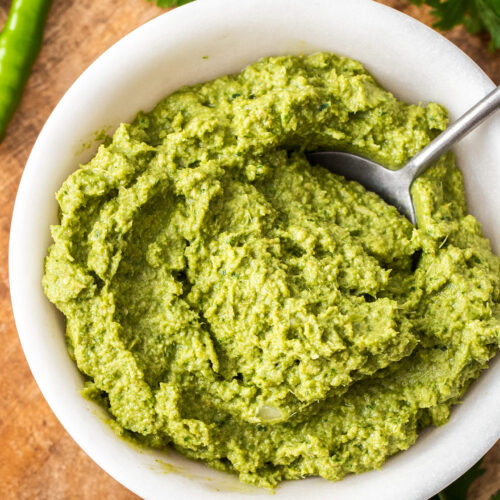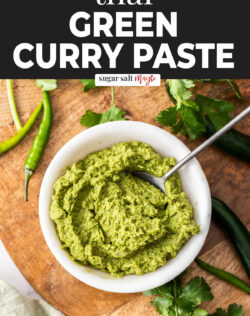With authentic flavour and packing plenty of heat, making Thai green curry paste is simple and easily adaptable to your tastes. It can also be frozen, so you can make a big batch and freeze for when you want a truly homemade Thai green curry.
- Loaded with flavour and a good spicy kick.
- Uses authentic ingredients.
- Can be made ahead and can be frozen for later.
- Makes any Thai green curry dish a breeze to knock together.
I adore Thai food so when I created by Thai green chicken curry, I had to create my own thai curry paste too. This fragrant paste can be used to create comforting curries in a hurry and making it from scratch means you can control the precise flavour and heat you want with the freshness you just can’t get from a jar.
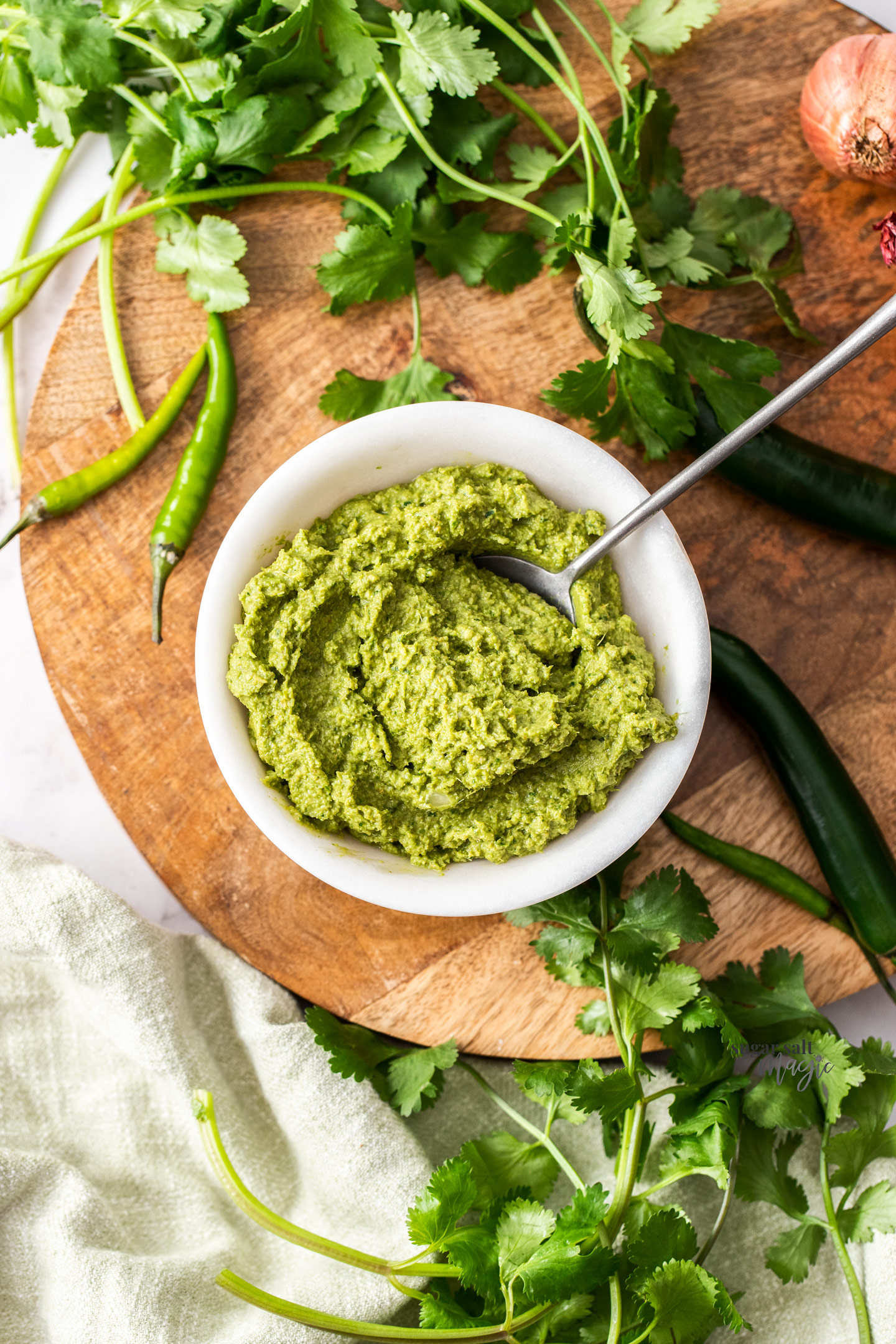
Never Miss a Recipe!
Get the latest recipes straight to your inbox!
What is Thai green curry paste?
The flavour base for the classic Thai green curry that originated in central Thailand, this curry paste is a blend of fresh herbs and spices with a spicy kick. The colour comes mainly from the use of green chillies and coriander (cilantro). These green ingredients are what differentiates it from red curry paste.
Ingredients for thai green curry paste
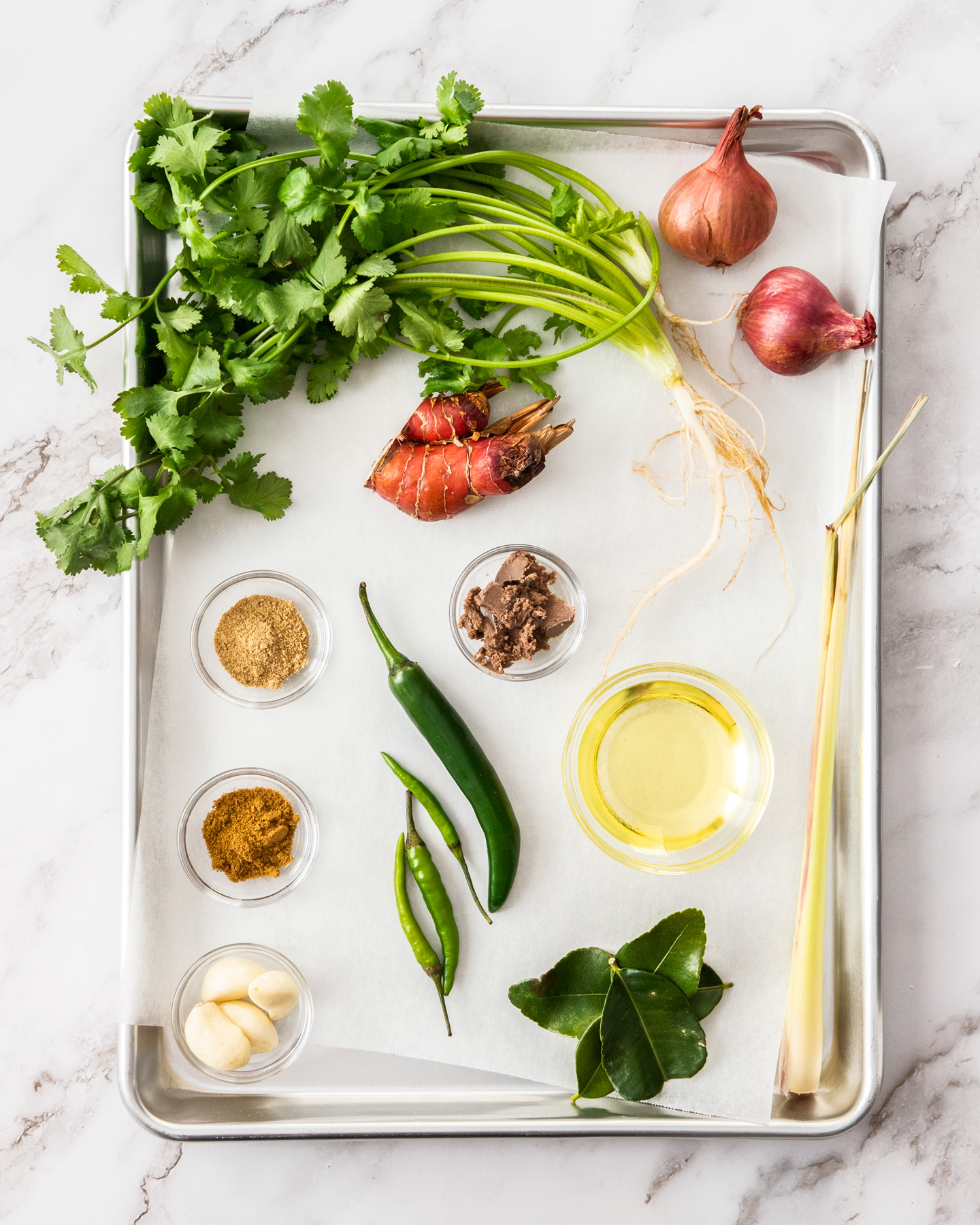
Detailed quantities and instructions in the recipe card below.
Firstly, why would you make your own green curry paste?
The answer is simple but also has multiple answers.
- It’s easy so why not give it a go.
- It gives you back control over flavours, heat level and knowing what’s in your food.
- Curry paste made from scratch has freshness that the jarred variety just can’t provide.
Jars of green curry paste can be incredibly convenient – hey, I use them too and I definitely don’t judge. It adds good flavour quickly. They do however tend to be either very salty or very sweet and not necessarily authentic.
There is no salt or sugar in a traditional paste, with those flavours being added to the final dish instead, however, my favourite jarred variety Ayam is actually quite sweet while another popular brand, Maesri I find very salty. By making it yourself and you get more control over all that flavour.
The hardest part really is to gather your ingredients. Most can be found at your supermarket though if you head straight to your local Asian grocer, they’ll likely have everything you need in the one place. From there you just need a blender and 15 minutes and it’s done.
- Shallots: Traditionally, Asian shallots would be used which are just very small and similar to French shallots. I use French shallots here.
- Garlic: We all know garlic. That robust umami ingredient that just adds so much flavour.
- Ground coriander and ground cumin: Traditionally, both coriander seeds and cumin seeds would be toasted whole, then pounded with a mortar and pestle into the paste. To keep things simple I use the dried, pre-ground versions but make sure to get them nice and fresh as spices in your spice rack do go stale very quickly.
I’ve included photos for the remaining, possibly less familiar, ingredients.
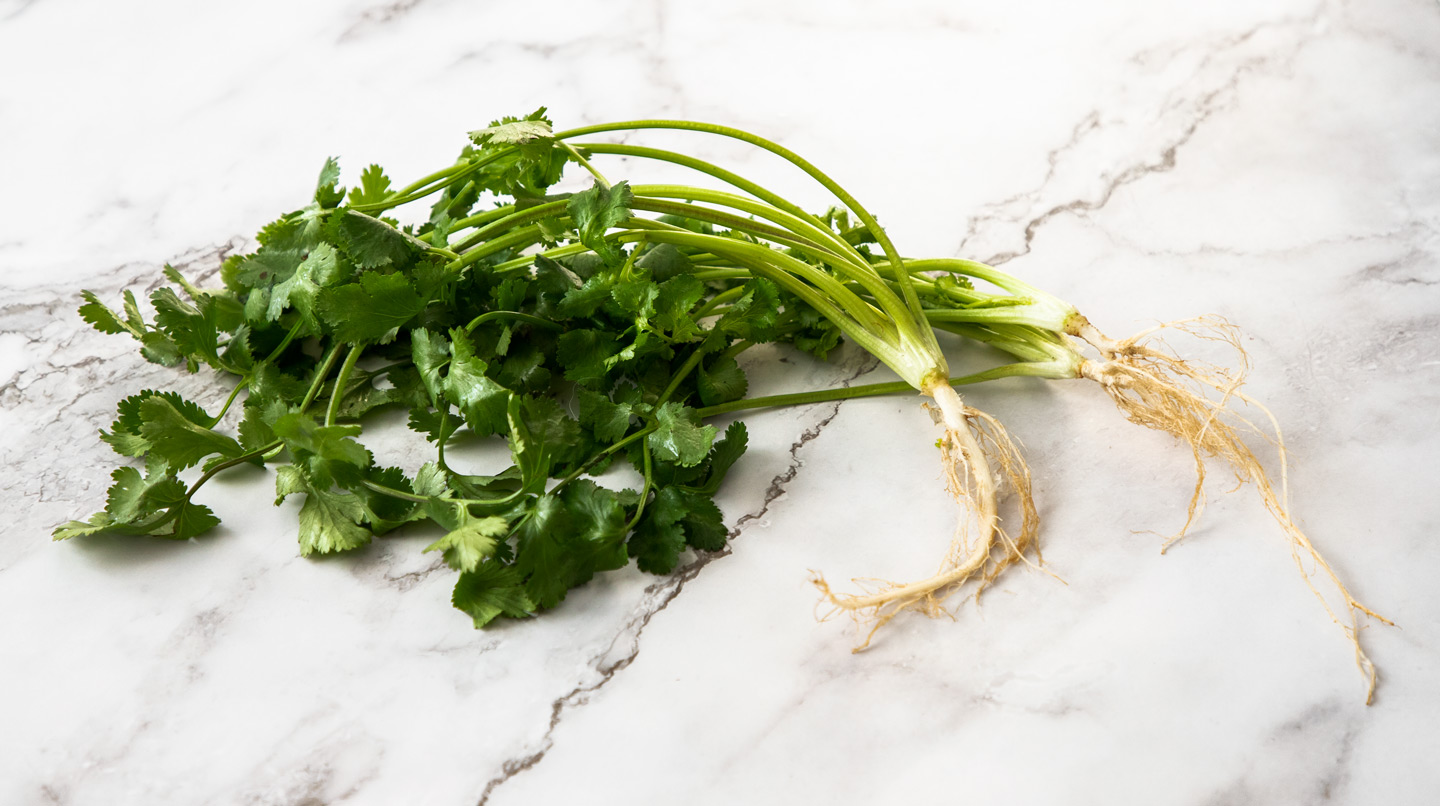
- Coriander / Cilantro: Most will know coriander (also known by the name cilantro) however you may be unfamiliar with using the whole herb – roots and all. Don’t throw away those root, instead you need to give them a good wash and add them to your curry paste.
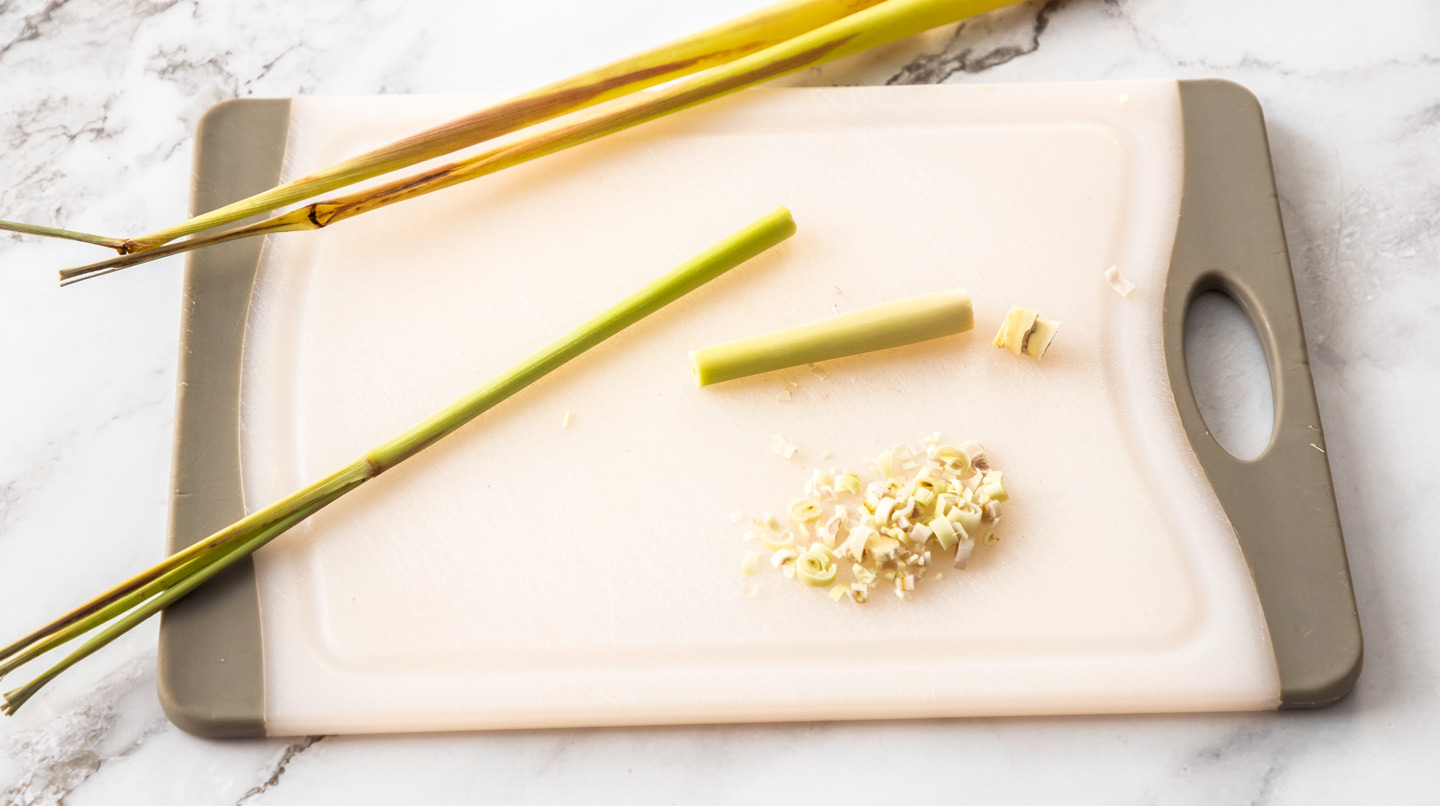
- Lemongrass: Stalks of lemon grass add phenomenal fragrance and flavour. With a lemony flavour and also a floral aroma it’s a classic Thai ingredient. You’ll need to peel away the outer drier leaves, and only need the white part of the stalk (the bottom 8-10cm). It’s quite fibrous so chop it up a bit first. Don’t throw away the top section either. That can be frozen and added to Asian style soup or broth, or even added into the rice while it cooks to add some fragrance.
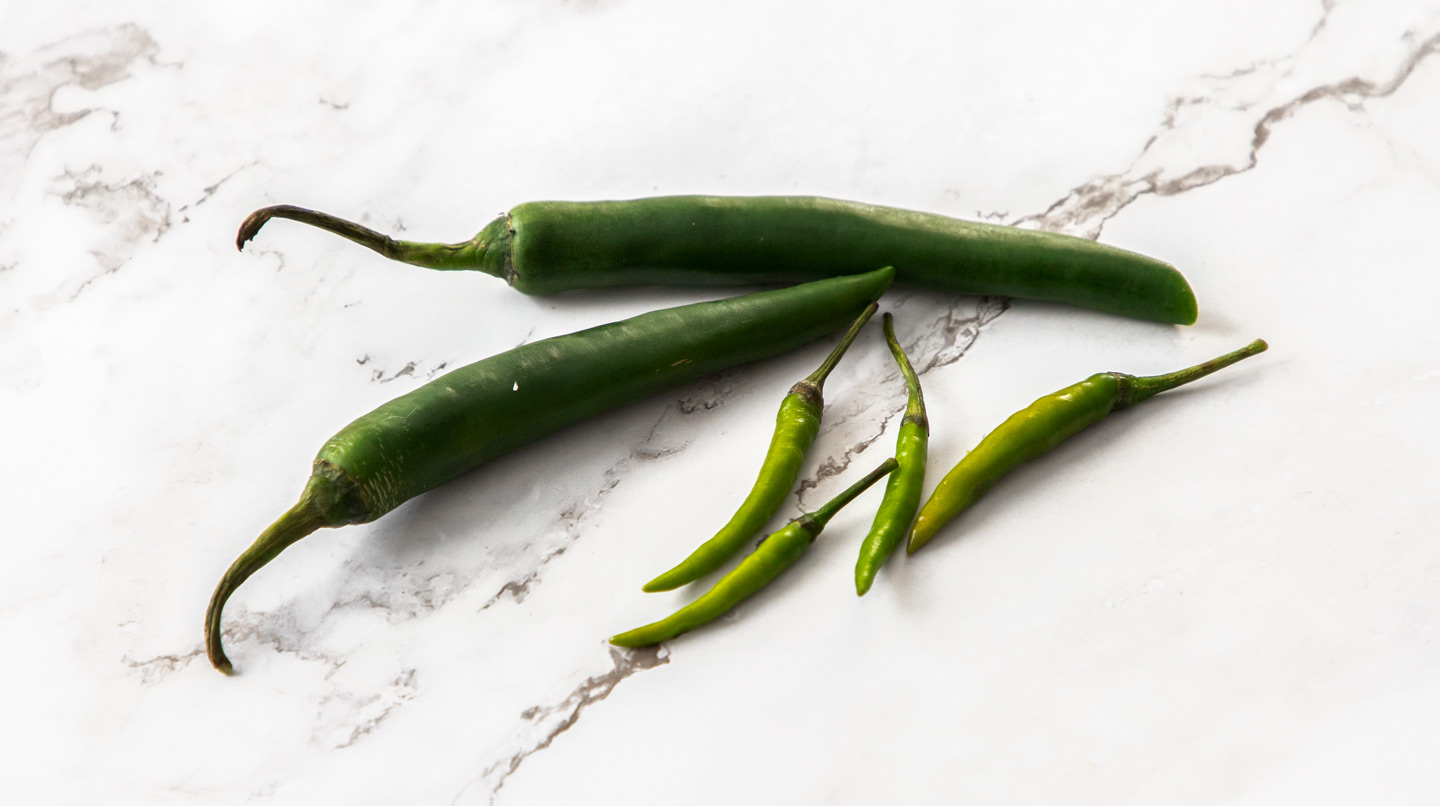
- Green chillies: Hot Thai green chillis (the small ones above) may be miniature in size but they pack a serious punch. These tiny little green chilies are very spicy. If you can get those, they’re perfect. If not, you can add a second or even third long green chilli (the large ones above) in their place. This recipe contains both. The smaller ones mainly for heat and the larger ones for colour and flavour, plus a little extra heat.
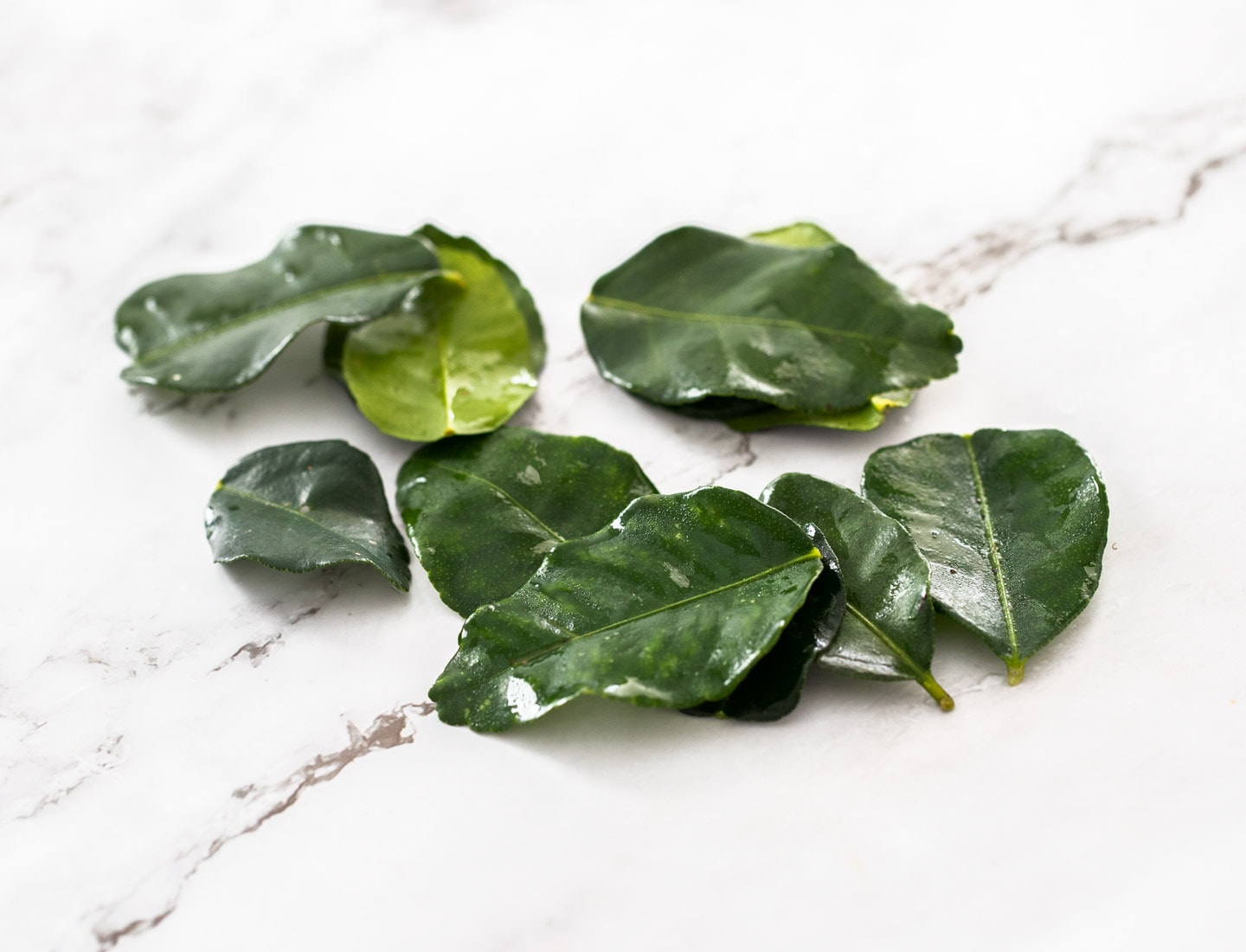
- Makrut lime leaves: Also known as Kaffir lime leaves, Makrut lime leaves are another fragrant, citrusy flavour and always part of a traditional Thai green curry paste. Many recipes call for a quantity of leaves just as I have but this can be confusing, since some of them come individually and others come with two leaves joined together. To make things easier, just fill one tablespoon with roughly chopped leaves without packing them in.
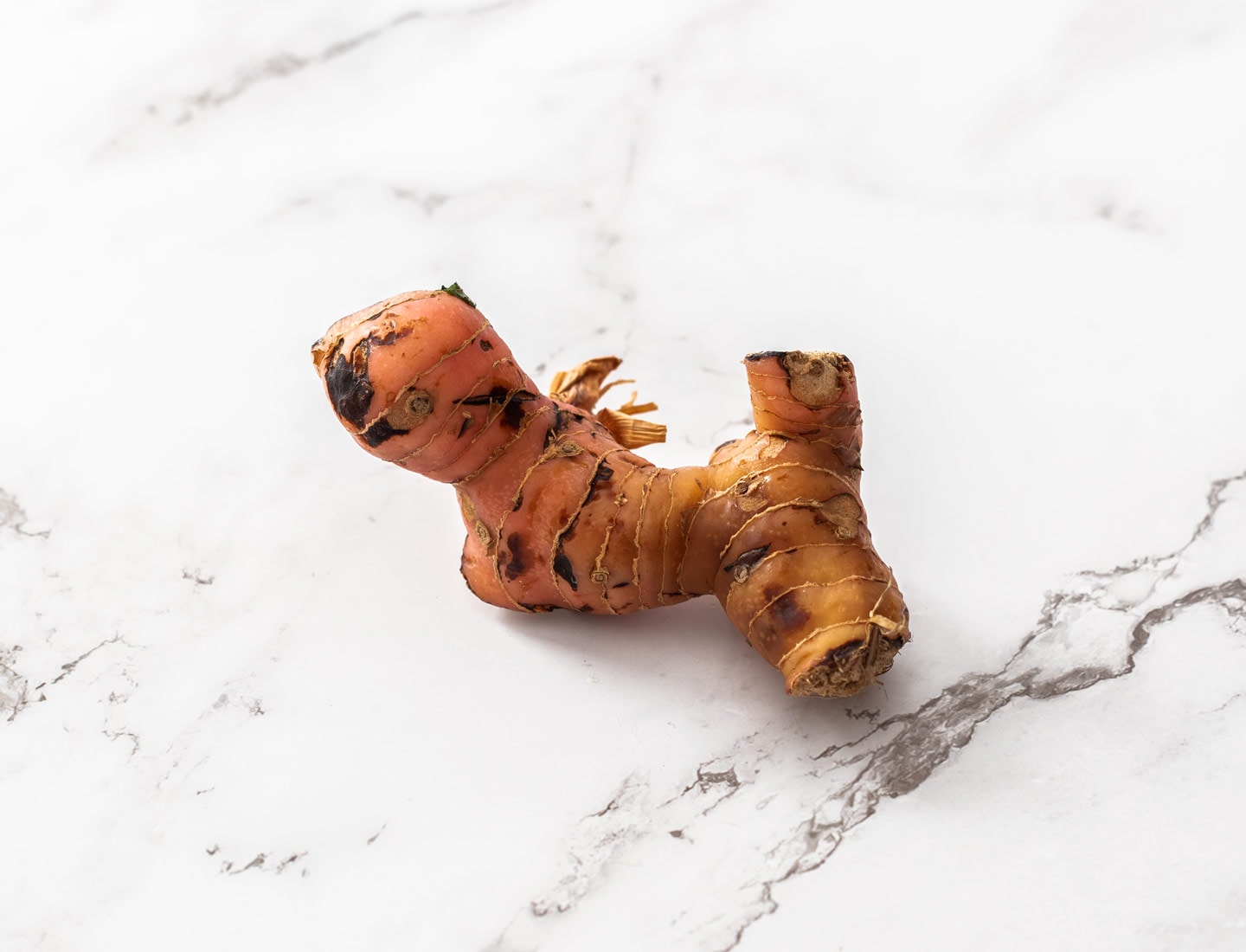
- Galangal: This citrusy, fragrant root looks a little like ginger except it’s pink. It’s part of the ginger rhizome family but is all at once more sweet and more bitter than ginger. If you’re in a bind and just can’t find it anywhere, use ginger and a touch more lemongrass.

- Dried Shrimp paste / Belachan / Belacan: Extremely pungent, it’s a little like fish sauce in that the smell can be off putting for some (and not for others) but it adds so much flavour and umami. It’s fermented, salted shrimp that comes in an almost ‘stock cube form’. Pre-roasted means you don’t need to cook it before adding to the blender. Do not leave this ingredient out. While it’s a bit stinky, it doesn’t taste the way it smells and it’s so important to a green curry. Here is the dried shrimp paste I use on Amazon. If you have trouble getting it, just add a teaspoon of fish sauce to your blender in it’s place.
Again, most of these ingredients are now available in big supermarkets / grocery stores but if you know a good Asian store, head there as they’re bound to have it all. You can see more information on some of these ingredients in my essential Thai ingredients post.
How to make thai green curry paste it (step-by-step)
Detailed quantities and instructions in the recipe card below.
Now that we’ve gathered our ingredients, let’s get to making our homemade green curry paste. The one and only tool you need (aside from a sharp knife and chopping board) is a powerful blender or food processor. There are a number of fibrous and woody ingredients in green curry paste so you need a good blender to get it as smooth as possible.
And that’s really it. Once your ingredients are prepped, just add them all to the blender and blend until smooth. You may need to remove the blender jug and give it a shake every now and then but it will eventually get going and turn into paste.
If you want to be super authentic, make your green curry paste with a mortar and pestle. This takes time and elbow grease and it’s much quicker and easier to use a blender.
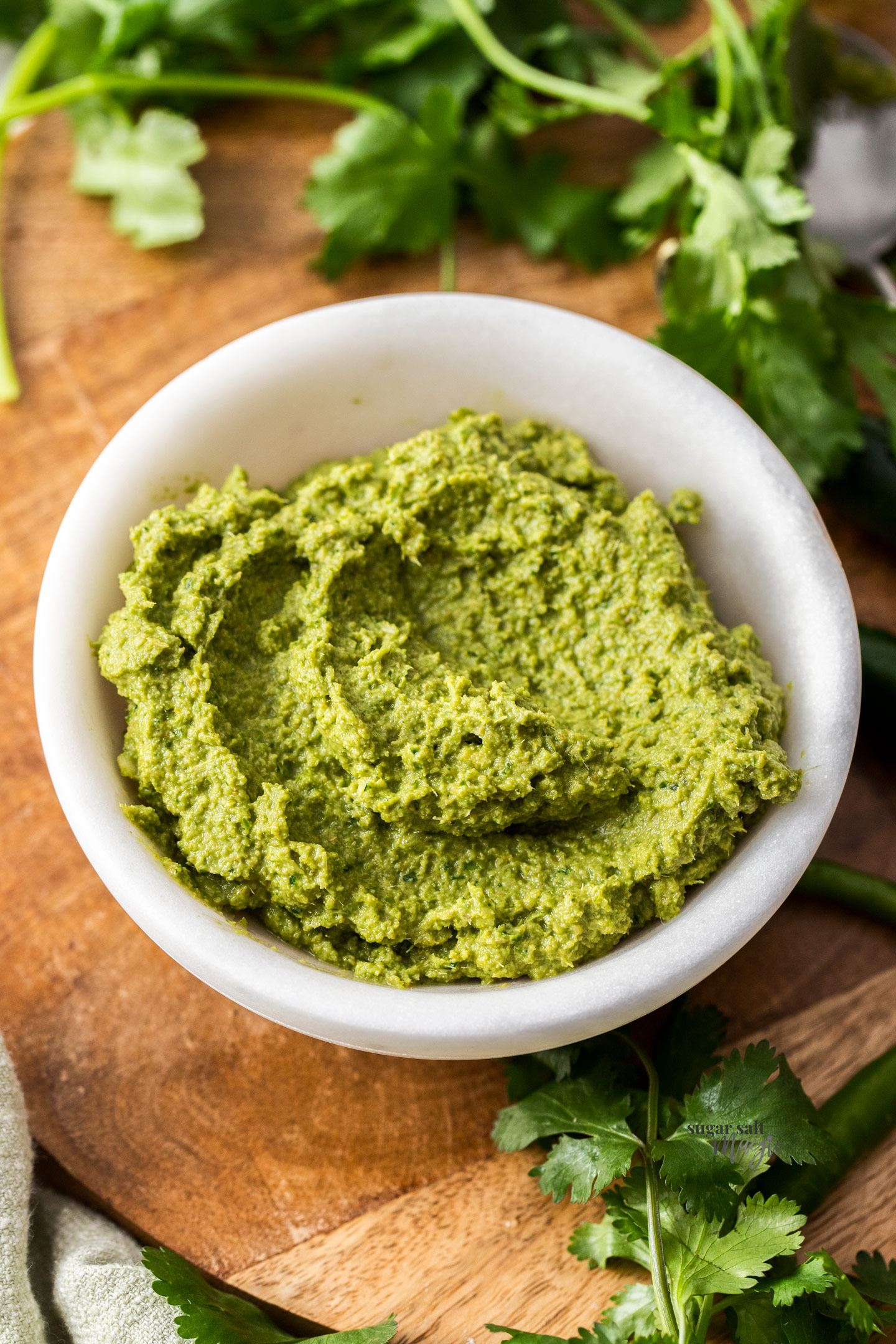
How to use green curry paste
It goes almost without saying that the best way and most common way to use green curry paste is in a Thai green curry like my Thai green chicken curry. Just add some coconut milk, vegetables and protein of your choice and you have a wonderfully aromatic and comforting curry. But it’s uses aren’t limited to that.
I also use this in my Thai fish cakes.
Try a little green curry paste mixed through your salad dressings to spice them up. Add it soups and stir fries too.
FAQs
Yes, Thai green curry paste – at least this homemade version – is gluten free.
Due to the shrimp paste, green curry paste is neither vegan or vegetarian. To get that same kind of umami, I would substitute it with miso or a fermented soy bean paste.
Yield and storage
This recipe makes about ⅔ cup of Thai curry paste.
The fresh paste can be stored in an airtight container in the fridge for 3-4 days.
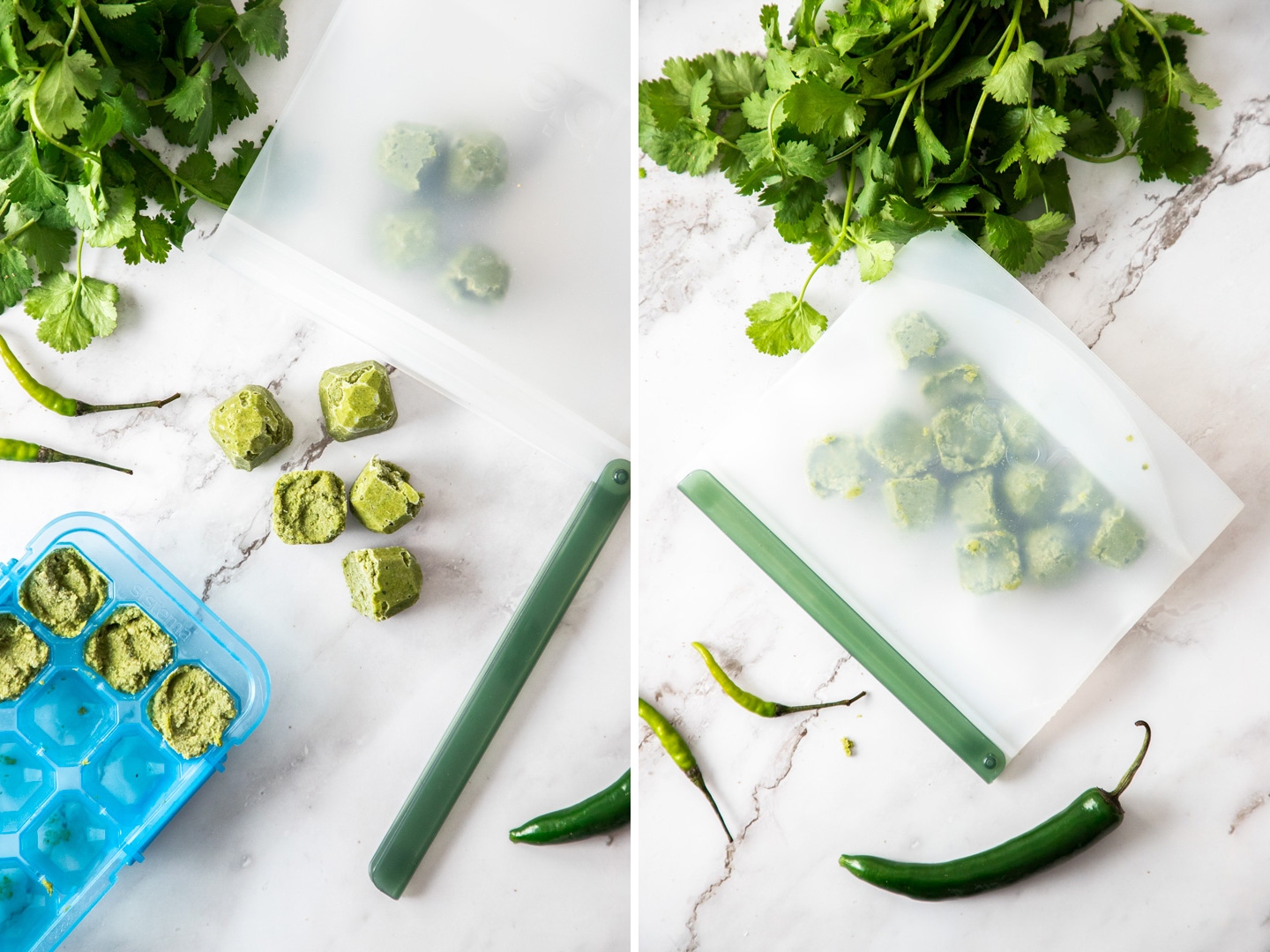
Can you freeze curry paste?
Yes, you can freeze green curry paste too – see photo above. The easiest way is to freeze it in ice cube trays then, once solid, transfer them to an airtight container or bag for up to 2 months. I love using these reusable silicone bags. That link is for Amazon but Aldi quite often have them on sale too.
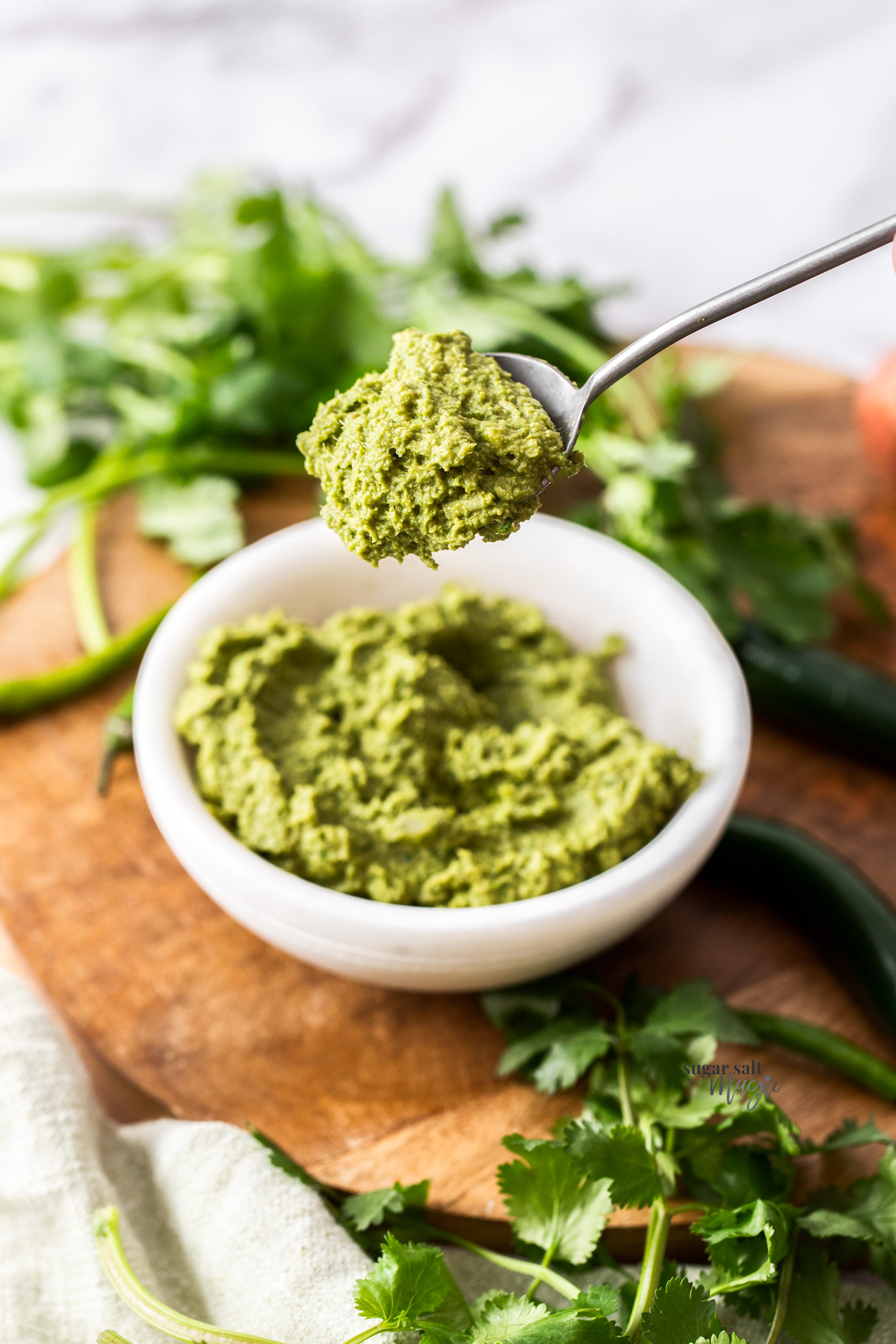
Did you try this recipe for green thai curry paste?
Leaving a rating and comment below the recipe is so helpful!
Hungry for more? Subscribe to the newsletter for free recipes straight to your inbox. Also, follow along on Facebook, Pinterest and Instagram.
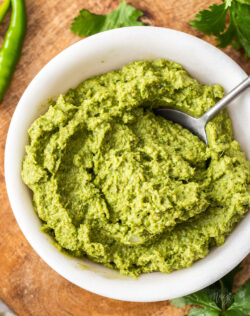
Ingredients
- 2 bunches coriander (cilantro), with their roots (roughly 1 cup)
- 1 extra coriander (cilantro) root
- 3 Asian or small French shallots (1/3 cup roughly chopped)
- 2 stalks lemongrass (bottom 8-10cm only), roughly chopped
- 3 hot thai green chillies, seeds removed (2 teaspoons roughly chopped or more to taste) (notes)
- 1 long green chilli, seeds removed
- 3 finely chopped makrut lime leaves (kaffir lime leaves), finely sliced (1 tablespoon finely sliced, NOT packed)
- 1 inch square piece galangal, roughly peeled then finely chopped
- 4 cloves garlic, peeled
- 2 teaspoons dried shrimp paste
- 1 teaspoon ground coriander
- 1 teaspoon ground cumin
- 2 tablespoon peanut oil or veg oil
For best results, always weigh ingredients where a weight is provided
Instructions
- Coriander: Wash and give the roots a good scrub to remove the dirt. Roughly chop the whole lot and put it into a powerful blender (notes).
- Add the remaining ingredients
- – roughly chopped shallots, lemon grass and chillies,
- – the finely sliced lime leaves and galangal,
- – garlic cloves, shrimp paste, ground coriander, cumin and oil.
- Blend to a paste. You may need to remove the blender from time to time and give it a good shake but it will start blending down after a while and turn to a paste. You’ll want to get everything as fine as possible so you aren’t left with big bits of fibrous ingredients. This takes 5-6 minutes with my Ninja blender.
- Store in the fridge in an airtight container for 3-4 days or freeze in ice cube trays, transferring to an airtight container to freeze for up to 3 months.
- Please take a moment to leave a comment & rating. It's appreciated and so helpful.
Notes
- Blender: You can also use a mortar and pestle to gradually blend it all together but just add one ingredient at a time and grind before adding the next one. Coriander / cilantro is used roots and all so make sure the roots are cleaned well.
- Thai green chillis: This fiery little green chillis pack a lot of heat. Add however many you like to taste. I find 3 with the long green chilli adds enough heat to be spicy without working up a sweat but chilli heat varies from place to place too. Test the intensity once the paste is blended, then add more chilli if needed. You may need to visit an Asian grocery store for the small chilies.
- Makrut lime leaves are also known as kaffir lime leaves available from many supermarkets.
- Galangal: Available in many supermarkets these days, galangal is similar to ginger but more citrusy, sweet and bitter all at once. If you can find it, use ginger and add the zest of one lime as well.
- Dried shrimp paste: Make sure to get dried shrimp paste, also known as belachan / belacan, and not the jarred paste. Here is the dried shrimp paste I use on Amazon. Some dried shrimp pastes are often found at supermarkets or you can find it in an Asian grocery store.
- Oil: Don’t use more oil than required to slowly blend this together. This paste does take a while to blend together and adding too much oil to get it going will just create a very greasy paste. See the post details for more information on everything.
- Cooking the paste: In most instances, depending on how you’re using the paste, it is best fried for a minute or two before adding to your recipe. For instance, in a Thai green curry, you would fry this off before adding any liquid to the dish.
- Yield: This recipe makes about ⅔ cup.
This post may contain affiliate links that earn me a small commission for my referral, at no extra cost to you. Thank you for supporting Sugar Salt Magic.

